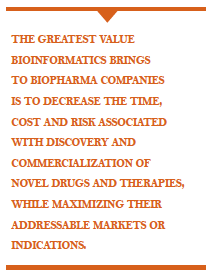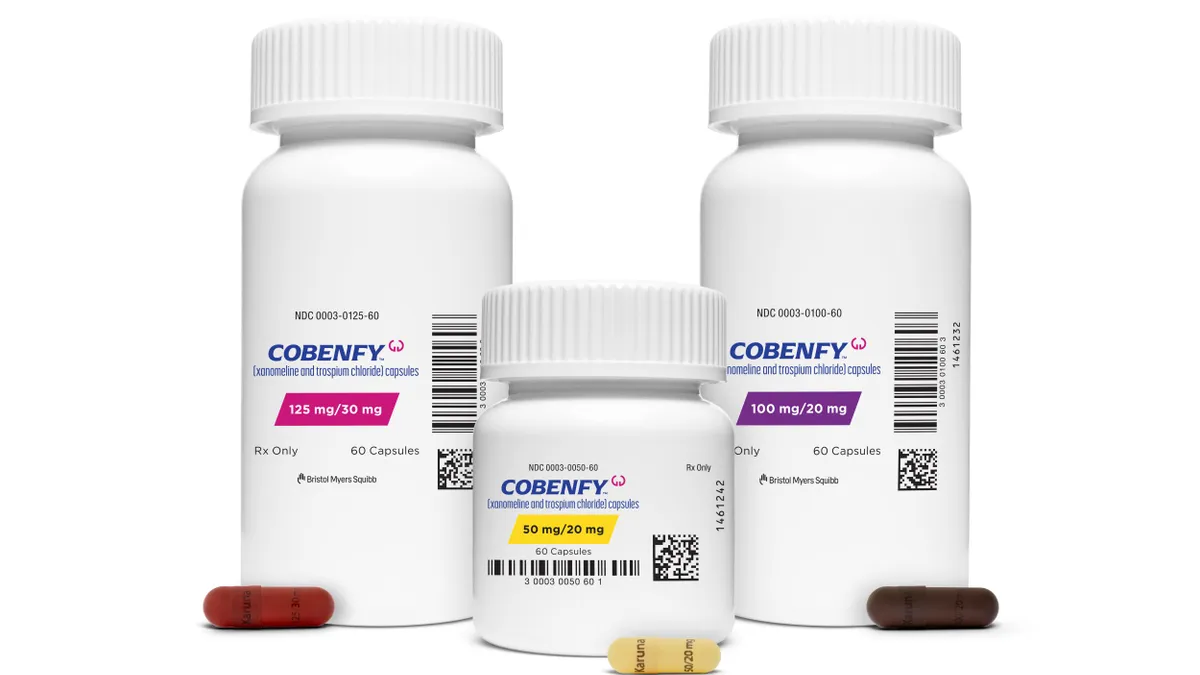 While the rate of approval of novel life-changing precision medicines is on the rise, the economics facing those who discover, commercialize, and are in need of such medications are untenable. The combination of the increased development costs and more narrowly targeted patient populations of precision medicine have driven down biopharma internal rates of return and have made vital cures financially inaccessible to patients in need. One way to mitigate this dynamic is for biopharma companies to leverage a unified bioinformatic ecosystem that can effectively reduce the time, cost and risk associated with the discovery and commercialization of novel drugs, while increasing efficacy across a larger number of indications to expand addressable markets.
While the rate of approval of novel life-changing precision medicines is on the rise, the economics facing those who discover, commercialize, and are in need of such medications are untenable. The combination of the increased development costs and more narrowly targeted patient populations of precision medicine have driven down biopharma internal rates of return and have made vital cures financially inaccessible to patients in need. One way to mitigate this dynamic is for biopharma companies to leverage a unified bioinformatic ecosystem that can effectively reduce the time, cost and risk associated with the discovery and commercialization of novel drugs, while increasing efficacy across a larger number of indications to expand addressable markets.
As CEO of Seven Bridges, Bill Moss is drawing on his background as an industry visionary to put his company at the forefront of this bioinformatics revolution. Throughout his career, Bill has focused on helping innovative companies — those with great vision, technology, science and people — to grow and create value. As an innovator and strategist, Bill understands where the bioinformatics field is headed and what the biopharmaceutical industry needs most from its partners to accelerate scientific discovery stemming from fast, secure and collaborative genomic and healthcare data analytics. Until recently, he says, bioinformatics was narrowly focused on cataloguing variant call format (VCF) text files generated from established reference genomes, and then performing tertiary analysis on those VCF files relative to a limited amount of phenotypic variables. But all of this is changing, and today bioinformatics is being used in silico for exploratory analyses and experimentation. The idea, he says, is to look for and identify biomarkers and focus those experiments to support new drug discovery solutions.
“The idea of experimenting in silico is not only to expand drug discovery but to identify broader applicable cohorts to maximize the value of, and markets for, those discoveries," he says.
It’s a shift that Bill says requires more robust computational platforms combined with scientific expertise within the biopharma industry.
“The ability to process the larger amounts of data that are now available more quickly is an IT solution that can be solved in many different ways, but IT doesn’t enhance the science or the  ability to accelerate the convergence around drug discovery and commercialization to maximize an addressable market," he says. “This is where we believe we distinguish ourselves as a bioinformatics solution provider."
ability to accelerate the convergence around drug discovery and commercialization to maximize an addressable market," he says. “This is where we believe we distinguish ourselves as a bioinformatics solution provider."
While technology certainly has been a driver of the advances in the informatics field, the major breakthroughs in genomic studies, and the massive increase in the amount of NGS data that are available, are changing the importance of informatics within biomedical research.
“The scientists in our industry are diving deeper and deeper into the human genome and discovering more and more ways to leverage that information to come up with amazing novel drugs and therapies," Bill says. “And this is happening much more economically. We realize as the science becomes more sophisticated, the needs of scientists become more sophisticated, which is why in silico experimentation is so important — to enable the science, not just the process."
Understanding the Value of Bioinformatics
One of the biggest barriers to bringing new cures to market is the cost of developing drugs. On one hand, the cost of sequencing a whole human genome dropped from $155,000 in 2010 to $1,000 in 2015, which has led to the discovery and development of more drugs with genomic biomarkers. On the other hand, the cost of developing a drug continues to rise, with current estimated total pipeline costs at around $2.6 billion per success.
One way to resolve this problem, Bill says, is to increase the efficiency of drug discovery by figuring out how to create the required efficacy of the target in larger drug cohorts. This means using bioinformatics to determine how a discovery can either be extended to other indications, to other cohorts or the development of derivative therapies from the original discovery.
“The greatest value bioinformatics brings to biopharma companies is to decrease the time, cost and risk associated with discovery and commercialization of novel drugs and therapies, while maximizing their addressable markets or indications," he says. “Bioinformatics can also reduce production costs — for example, by enabling companies to replace wet lab processes of cell line verification with in silico analyses, which have been accepted as valid verifications of those cell lines for production."
The promise that bioinformatics brings to help the industry achieve the mission of addressing genetic-related diseases is what excites Bill about the work Seven Bridges is doing.
“It’s only been in the past five years that the industry started to see the volume of NGS data accelerate and with that came an inflection point in the science, which is impacting the way bioinformatics is being viewed," he says. “Precision medicine in the genomics space is going to take off, and I’m excited to be a part of that."
Earlier this year, Seven Bridges released ARIA, the first cloud-based solution aimed at improving and accelerating the discovery of meaningful connections between genomics, health data and biological knowledge at the 1 million-plus participant scale. By connecting genetics and health outcomes at this scale, researchers at leading pharmaceutical organizations will be able to speed discovery in areas such as: classic and precision drug targets, increasing drug efficiency and reducing side effects through molecularly targeted populations, biomarkers that can be used to enable disease prevention and in silico exploration of the impact of inactivating a gene.
Security and Accessibility of Data
Data has the potential to reveal transformative insights into the underpinnings of disease, novel therapeutic approaches and in silico disease models. According to Bill, current technologies are ill-equipped to effectively handle the scale, complexity and disparate modalities of data being generated.
“Data is a key aspect to the overall advancement of the science of drug research," Bill says. “Today, numerous initiatives are underway globally to collect massive repositories of genomic data, but in many cases these large repositories of data have not been leveraged to the fullest extent possible."
To understand the reasons why, it’s important to first assess the factors that define the value of a given repository. According to Bill, these include the size of the population, the specificity of that population to the objective of the analytics, the quality and volume of both the genomic data and the phenotypic data and finally, accessibility.
“There are times when a large horizontal population is critical — for example, to understand trends within the data — and at other times having a smaller, highly targeted population is critical for a study, for instance, one that is looking at understanding the importance of tumor-normal pairs in a type of cancer within a specific population," Bill says. “Regardless of the study purpose, the key is accessibility and, more to the point, properly secured data accessibility. A data repository has to be secure enough to protect the patients’ information and the value of the asset but accessible enough so that the data can be used."
According to Bill, the issue of accessibility combined with security is one of the distinct advantages Seven Bridges has. The company is the only commercial entity to achieve trusted partner status with the National Institutes of Health (NIH), which allows Seven Bridges to provide authorized access to patients’ data from various NIH programs.
“We’ve been working over the past several years to optimize the balance between accessibility and collaboration versus security and compliance," he says.
Seven Bridges is working across several global genome projects behind the scenes to democratize federated data and to optimize the use of that data through platforms, including multi-regional multi-cloud environments. As the pioneers of the common workflow language (CWL), Seven Bridges continues to play a key role in its definition and development, ensuring the portability and interoperability of workflows.
“Properly securing accessibility of the data and creating interoperability of the tool sets will ultimately bring the scientific research and development community — across both academia, commercial biopharma and the learning health systems — together to collaborate more effectively," Bill says.
Building the Relationship
To advance the goals toward greater productivity in drug development, increasing successes, reducing costs and decreasing timelines, the relationship between a bioinformatics solution provider and the stakeholders within the research community must be one of collaboration. Bill describes five areas where a solution provider can support the relationship with an internal R&D team.
Community or scientific thought leadership: Internal sponsor company R&D teams are looking for an organization that is driving the industry and the science by working with various public programs, government programs and academia and offering technologies, solutions and services to help the sponsor organization interact with that broader community.
An underlying collaborative platform: A comprehensive, unified bioinformatics ecosystem creates collaboration within the internal sponsor R&D group, as well as with other groups within the company and beyond. The platform must support the ability to do complex bioinformatics from in silico analytics, analysis and experimentation to drive discovery of cohorts with the greatest efficacy and broadest application.
Bioinformatics for the future: A bioinformatics solutions provider needs to be developing next-generation capabilities that remove bias from the process, increase accuracy and optimize exploration.
Professional services: As sponsor organizations evolve and grow, they will need bioinformatics capabilities as they launch into new areas, as well as scientific support in terms of capacity and/or efficiency.
Curator of content: To advance their scientific endeavours, biopharma companies will need access to bioinformatics companies that have access to large repositories and tool sets from public programs, research communities or national levels to run.
While the partnership between biopharma companies and their bioinformatics service provider is key, Bill emphasizes that the provider is there to support the biopharma company’s success, not to replace the expertise of its internal scientists.
The key to being a good partner, he says, is about offering a specialized service, working shoulder to shoulder with biopharma clients and helping them to achieve their objectives.
And that means being trusted by the client — something Seven Bridges can demonstrate thanks to its trusted partner status with the NIH and many large biopharma clients.
Bill is truly excited to be a part of the Seven Bridges team, driving to enable biopharma research organizations to optimize the precision medicine discovery through commercialization life cycle.
“Our team is extremely dedicated to revolutionizing the discovery, development and commercialization of novel drugs, therapies and biotechnologies, enabling a greater number of precision medicine solutions to be made available to an ever-increasing number of highly targeted patient populations, resulting in transformative advancements in life sciences and a healthier global population." n



















